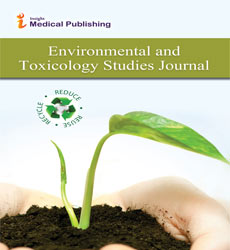Environmental Toxicology in the Era of Climate Change: New Challenges for Ecosystem and Human Health
Sophie Jaumot*
Department of Nutrition and Dietetics, Kogi State University, Kogi, Nigeria
*Corresponding author:
Sophie Jaumot,
Department of Nutrition and Dietetics, Kogi State University, Kogi, Nigeria,
E-mail: chiara@lidia.sp
Received date: February 01, 2025, Manuscript No. IPETSJ-25-20611; Editor assigned date: February 03, 2025, PreQC No. IPETSJ-25-20611 (PQ); Reviewed date: February 15, 2025, QC No. IPETSJ-25-20611; Revised date: February 22, 2025, Manuscript No. IPETSJ-25-20611 (R); Published date: February 28, 2025, DOI: 10.36648/.9.1.3
Citation: Jaumot S (2025) Environmental Toxicology in the Era of Climate Change: New Challenges for Ecosystem and Human Health. Environ Toxicol J Vol.9 No.1:3
Introduction
Climate change is intensifying the distribution, persistence, and biological impact of environmental pollutants, creating novel challenges for ecosystem integrity and human health. Rising temperatures, altered precipitation patterns, and extreme weather events can influence the mobility, bioavailability, and degradation of chemical contaminants such as heavy metals, persistent organic pollutants, and pesticides. Environmental toxicology in this era must therefore account for the synergistic effects of climate-related stressors and pollutant exposure, emphasizing the need for advanced monitoring, predictive modeling, and adaptive mitigation strategies to protect both ecological and human populations [1].
Description
Climate-driven environmental changes can alter the transport and fate of pollutants, increasing their bioaccumulation in terrestrial and aquatic food webs. For example, elevated temperatures can enhance volatilization of organic chemicals, while flooding and soil erosion can redistribute heavy metals and agricultural residues into previously unaffected regions. These changes increase the likelihood of human and wildlife exposure and can amplify toxicological effects through combined stressors, including heat, hypoxia, or altered pathogen prevalence. Understanding these interactions is critical for assessing cumulative risk under climate change scenarios [2].
The health implications of climate-augmented toxic exposure are multifaceted. Increased pollutant bioavailability may exacerbate respiratory, cardiovascular, and metabolic diseases, particularly in vulnerable populations such as children, the elderly, and communities in high-exposure regions. Moreover, climate-sensitive pathways, including endocrine disruption, neurotoxicity, and immunomodulation, can be amplified under environmental stressors, resulting in heightened susceptibility to chronic illnesses and infectious diseases [3].
Epidemiological studies increasingly underscore the interplay between environmental contamination and climate-related health burdens, highlighting urgent public health priorities. From an ecological perspective, climate change can synergize with toxic exposures to disrupt ecosystem balance. Pollutants may interfere with species reproduction, growth, and survival, while climate-induced stressors such as temperature shifts, altered precipitation, and habitat loss can compound these effects [4].
Such interactions threaten biodiversity, reduce ecosystem services, and compromise resilience to further environmental disturbances. Effective toxicological assessment now requires integrating climate projections with chemical risk analysis to guide conservation and public health interventions. Such interactions pose serious threats to biodiversity by endangering species survival, diminishing essential ecosystem services, and weakening natural resilience against future environmental stressors. To address these challenges, toxicological assessments must evolve by integrating climate projections with chemical risk analyses, allowing for more accurate predictions of ecological and health impacts. This holistic approach not only guides conservation strategies but also strengthens public health interventions [5].
Conclusion
Environmental toxicology in the context of climate change demands a comprehensive understanding of how global environmental shifts influence pollutant behavior, exposure pathways, and health outcomes. Addressing these challenges requires multidisciplinary approaches combining monitoring, modeling, and risk assessment to anticipate emerging threats. By integrating climate considerations into toxicological research and policy frameworks, it is possible to develop adaptive strategies that protect ecosystem integrity and human health in a rapidly changing environment.
Acknowledgement
None.
Conflict of Interest
None.
References
- Ankley GT, Daston GP, Degitz SJ, Denslow ND, Hoke RA, et al. (2006) Toxicogenomics in regulatory ecotoxicology. Environ Sci Technol 40: 4055–4065
Google Scholar Cross Ref Indexed at
- Fabrello J, Grapputo A, Munari M, Marin MG, Masiero L, et al. (2020) Molecular and biochemical responses of vitellogenin in the mussel Mytilus galloprovincialis exposed to the glyphosate-based herbicide Roundup® Power 2.0. Environ Sci Pollut Res 27: 26543–26553
Google Scholar Cross Ref Indexed at
- Kircher M, Kelso JJ (2010) High-throughput DNA sequencing–concepts and limitations. Bioessays 32: 524–536
Google Scholar Cross Ref Indexed at
- Martin JA, Wang Z (2011) Next-generation transcriptome assembly. Nat Rev Genet 12: 671–682
Google Scholar Cross Ref Indexed at
- Trapp J, Armengaud J, Salvador A, Chaumot A, Geffard O (2014) Next-generation proteomics: toward customized biomarkers for environmental biomonitoring. Environ Sci Technol 48: 13560–13572
Open Access Journals
- Aquaculture & Veterinary Science
- Chemistry & Chemical Sciences
- Clinical Sciences
- Engineering
- General Science
- Genetics & Molecular Biology
- Health Care & Nursing
- Immunology & Microbiology
- Materials Science
- Mathematics & Physics
- Medical Sciences
- Neurology & Psychiatry
- Oncology & Cancer Science
- Pharmaceutical Sciences
